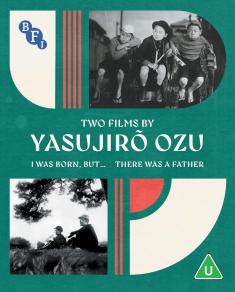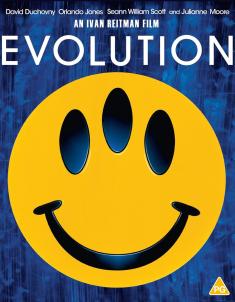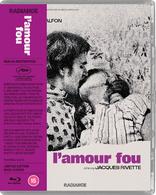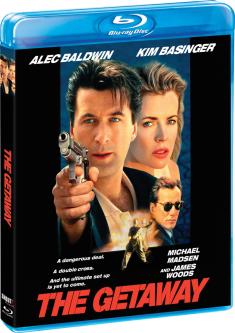Gladiator
Overview -Storyline: Our Reviewer's Take
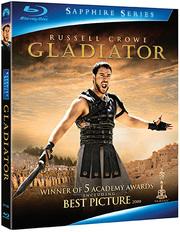
Roman epics are as much a part of cinematic history as Lassie and John Wayne. Ever since the silent era and on through such mammoth works as 'Quo Vadis,' 'The Robe,' 'Ben-Hur,' and 'Cleopatra,' studios and audiences have been hopelessly seduced by the ancient empire's intoxicating blend of decadence, intrigue, and grandeur. Yet for every iconic Roman film produced, Hollywood has churned out at least one colossal dud, often swallowing a bitter box office pill when flat receipts proved time and again that spectacle alone isn't enough to keep a sword-and-sandal saga from sinking into the dust.
The genre's inherent traps have sandbagged many a lofty director, but Ridley Scott navigated the minefield well, and 'Gladiator' is the glorious result – a film rich with passion and narrative drive that both followed a timeworn blueprint and blazed its own trail. With a masterful sense of rhythm and timing, Scott combined old school elements with contemporary technique to produce a riveting, often thrilling work that redefined the Hollywood epic and earned five well-deserved Academy Awards, including Best Picture and Best Actor (Russell Crowe). Though he didn't hesitate to pull the trigger and go for broke visually, Scott shrewdly picked his moments, and never loosened his grip on the tenuous emotional thread that keeps the movie grounded. 'Gladiator,' unlike many blockbusters, has heart and more than a little soul, and that, along with Crowe's brawny, brooding presence, is what makes this movie a modern classic.
After defeating a holdout tribe of Germanic barbarians in 180 A.D., Rome's most decorated general, Maximus Meridas (Crowe), wants nothing more than to retreat to his country farm and commune with his wife and young son. But Emperor Marcus Aurelius (Richard Harris) has other ideas. The dying despot abhors the direction in which Rome is heading, and longs to end the "crippling corruption" he fears will one day destroy the empire. Giving power back to the people and returning to a republican form of government is Marcus' last wish, and he anoints Maximus, a symbol of honor, morality, and strength, the caretaker of his dream. Under Marcus' plan, Maximus will become "Protector of Rome," and maintain order until the Senate is strong enough to rule again. "You are the son I should have had," Marcus tells him, and though the emperor's real son, the neglected and insatiably ambitious Commodus (Joaquin Phoenix), doesn't hear the comment, he still senses he's fallen out of his father's favor.
Sadly, Marcus doesn't live long enough to implement his plan. The unstable Commodus succeeds him, and almost at once he and Maximus clash. Tragedy ensues, and Maximus is captured by Proximo (Oliver Reed), an entrepreneurial slave trader who recognizes and exploits the fury burning within him. To gain his freedom, the noble Maximus becomes a gladiator, a one-man killing machine who thrills bloodthirsty crowds by viciously vanquishing any foe. And though his heroic deeds in the ring turn him into a sensation, he lives only to take brutal revenge on the society that betrayed him and the twisted emperor who took from him his most precious possessions.
It's rare to call a 155-minute film tight, but 'Gladiator' (even in its 171-minute extended edition) enthralls throughout. Like its hero, the movie's pacing is lean and mean, and no dead scenes drag it down. Scott's arresting style and the picture's top-flight production values keep the eye engaged, yet the veteran director knows when to tone down the stimuli and let the story unfold on its own. Oh sure, the opening battle and violent Coliseum sequences dazzle our senses, but the proof of Scott's pudding lies in its quieter moments, and with a wonderful narrative structure that seamlessly weaves Freudian undertones, political skullduggery, and sexual tension into its fabric, there's enough meat on 'Gladiator's' bulky frame to make the time fly by.
The actors help, too. Crowe, in his first collaboration with Scott (they would later team up for 'A Good Year,' 'American Gangster,' 'Body of Lies,' and the upcoming 'Robin Hood'), commands the screen, making Maximus much more than a big lug obsessed with revenge. Subtle touches abound in his deceptively simplistic interpretation, fleshing out the human qualities that fuel the gladiator's rage and torture his spirit. In a far juicier role, Phoenix tries his best to wrestle the picture away, and almost succeeds with an alternately heartbreaking and repugnant portrait of insecurity, anguish, cruelty, and perversion. Equally compelling performances from Harris, Reed, Connie Nielsen, Derek Jacobi, and Djimon Hounsou enhance the film, and their trained voices add mellifluous luster to the literate, Oscar-nominated screenplay.
Some sagas are stuffy, bloated, and empty. 'Gladiator' is none of those things. Its meticulous attention to detail, riveting performances, and breathtaking spectacle all combine to produce a powerful and memorable film that improves with each viewing. Reinventing and revitalizing an extinct genre is no easy task, yet by blending the best elements of the past and present, Scott succeeds brilliantly. In Hollywood's new epic competition, 'Gladiator' is the one to beat, and in the decade since its initial release, this bold yet poetic blockbuster has knocked off all challengers with the same snarling swagger as its hero.
Video Review
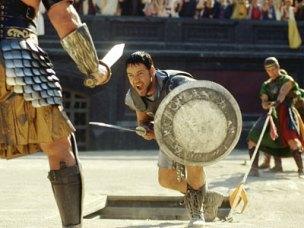
'Gladiator' has been hands down one of the most hotly anticipated high-def releases since the dawn of the Blu-ray format. The wait has been long, but when Paramount announced Ridley Scott's masterwork would be one of the inaugural titles in the studio's new top-of-the-line Sapphire Series, fans hoped their Job-like patience would be well rewarded. Expectations for a super-deluxe transfer rose to stratospheric heights, and then, like a bolt from the blue, came the screenshots-heard-'round-the-world, and enthusiasm plummeted. Several days before the disc's street date, videophiles showered isolated frames from the transfer across many internet forums (including ours), and decried the heavy use of edge enhancement and digital noise reduction, as well as excessive dirt and scratch removal filtering, that supposedly plagued the film. As a result, the 'Gladiator' controversy has become quite the Blu-ray cause célèbre, and the debate continues to rage. So, has this beloved title been irrevocably ruined by shoddy workmanship, cost-cutting, and a shameful disregard for both the film itself and the fundamental principles of present-day high-def transfer methods? Or, with apologies to Mark Twain, have the reports of 'Gladiator's' demise been greatly exaggerated?
I hate to be a fence straddler, but the answer lies somewhere in between. While I can't pretend to be the ultimate authority on this issue – no one (except maybe Ridley Scott) can – my particular set of eyes found the transfer to possess many of the faults described above, but nowhere near to the extent some of the more vociferous posters have stated. Yes, there's edge enhancement. Yes, there's DNR. I noticed both, but neither destroyed my viewing experience. On the whole, I found 'Gladiator' to be a very worthy upgrade from the previous DVD editions and a fine addition to the Blu-ray catalogue. Clarity is much improved, colors are brighter and bolder, the print is cleaner, and the picture possesses a much greater degree of depth and dimensionality. No, it is not the breathtaking, gasp-inducing effort many fans (including myself) expected, and Paramount promised with the silly Sapphire Series label. But casual viewers who just want to enjoy the drama and spectacle of this Oscar-winning epic with enhanced video and sound should be delighted. Diehard aficionados seeking perfection, however, undoubtedly will be frustrated.
So let's talk specifics. I watched portions of the extended edition of 'Gladiator' on two different displays – a 57-inch Mitsubishi DLP and a 46-inch Mitsubishi LCD. (My TV of choice is the DLP, as I feel the technology provides a more theatrical viewing experience.) The "smaller" screen sizes probably somewhat diminish the offensive digital doctoring, but whether one views the film on a 40-inch or 100-inch display, there's no denying the transfer possesses a definite processed look. Film-like warmth comes at a premium. While light grain lends the picture welcome, necessary texture, a sterile coldness often prevails. At its worst, the transfer makes some images appear almost superimposed on the screen, as excessive sharpening ever-so-slightly detaches figures from their backgrounds and gives certain scenes an artificial layered look. The DLP display was much more adept at masking such deficiencies (although they were still noticeable) and replicating the look and feel of true celluloid. The LCD display, on the other hand, was more unforgiving. Noise was much more visible in solid colors, the image adopted a harsher sheen, loss of detail was more apparent in panoramic shots, and print imperfections (such as errant white dots) were easier to spot. On both displays, however, the Blu-ray still beat upconverted DVD by a wide margin.
Perhaps the biggest problem with the 'Gladiator' transfer is that it's not a consistent effort. Rumor has it the bulk of the film was struck from a 2000 HD master (approved by Scott) in which digital enhancements were made, while the extended scenes are taken from a 2005 HD master that reflects today's more natural transfer standards. As I watched the movie via seamless branching, I really couldn't distinguish between the two per se. Yet upon reexamination, I noticed that while the extended scenes do flaunt a slightly more realistic, film-like look, they're not head-and-shoulders above every sequence in the theatrical cut. In fact, many stretches of the theatrical version rival the extended scenes.
Which brings me to my next point. At times, 'Gladiator' looks spectacularly good, with moments of jaw-dropping dimensionality, terrific detail, and sumptuous color. Though the first third of the film is awash in blue tones or a golden haze, both of which slightly mute contrast, vibrancy perks up measurably when Maximus is captured by the slave traders. The blue sky, green fields, red blood, and clay-colored earth all enjoy marvelous saturation. Fabric details and uniform adornments come through quite well, fleshtones look stable and natural, and black levels and shadow delineation are both stellar.
Much has been made about the scratch removal process defacing the image, especially with regard to arrows and fireballs that disappear and reappear in varying degrees of intensity from one frame to the next during the opening battle sequence. If you'd like to take the time to watch the film in slow-motion to find these instances, be my guest, but you won't see them at normal speed. (That doesn't excuse their existence, but it shouldn't keep anyone from purchasing this disc.) As far as DNR goes, it's there, but not employed so excessively that the actors look like wax figures moving through a Roman tableau at Madame Tussaud's. Facial features can look a bit smooth and at times lack the striking detail we expect from Blu-ray, but plenty of close-ups are razor sharp and absolutely stunning.
All in all, I have to say I've made my peace with this 'Gladiator' transfer. Could it better? Absolutely. Would I trade my copy if a replacement disc was pressed? In a New York minute. Will I toss this Blu-ray in a corner and forget about it until a better version is released? No. While it's far from the knock-my-socks-off, died-and-gone-to-heaven effort for which I and many others had hoped, it's also equally far from the sky-is-falling disaster others have claimed. Until a revamped version comes along, this one will certainly suffice.
Audio Review

Thankfully, no controversies swirl about the 5.1 DTS-HD Master Audio track, and only one word describes it: supreme! From the moment the first strains of Hans Zimmer and Lisa Gerrard's score flood the sound field during the movie's opening sequence, we know we're in for a thrilling sonic experience. Crisp, clear, well modulated, sweepingly dynamic, and discreetly mixed, this track is as muscular as Maximus himself, and complements the action with power, style, and nuance. Front channel separation is impeccable, with seamless pans creating a fluid and immersive audio environment, while the rears are almost constantly in play, adding palpable ambience to practically every scene. Some of the rear activity is so faint, it's almost imperceptible – a neighing horse, bits of scoring, hushed murmurs – yet the effects are so finely rendered they add immeasurable life to the drama.
Details shine, from cranking gears and clanking swords to the whir of shooting arrows and gentle breathing of a sleeping child. And when the track lets loose, it pummels us with the clamor of battle – exploding fireballs, the whoosh of a twirling flail, the slicing of human flesh – all expertly balanced and featuring the highest level of purity. The roaring crowd envelops with ease, and hefty bass adds weight to thunderous horse hooves and snarling tigers. Even when the audio is pushed to the limit, distortion is never an issue, as highs and lows seem limitless. This is truly you-are-there sound that makes us feel as if we're in the thick of the action with the characters – wandering a crowded bazaar, fighting to the death in the gladiator ring, flirting with an old flame, or frantically galloping home.
Dialogue is always perfectly prioritized, never yielding to other overlapping elements. The rich voices of Harris, Reed, and Jacobi come through with strength and authority, even during quiet scenes, as do Crowe's booming baritone and Phoenix's boyish tenor. Music is also expertly woven into the mix, and the robust tones possess excellent clarity and tonal depth as they alternately massage and punctuate the narrative.
Video buffs may be disappointed by 'Gladiator,' but audiophiles should cheer this reference quality track.
Special Features

'Gladiator' arrives on Blu-ray as part of Paramount's new Sapphire Series, and the two-disc set features hours upon hours of absorbing supplements, allowing fans to truly get lost in production minutia. All of the extras from the film's previous DVD editions are included, as well as two new interactive options that offer fresh material on a variety of fascinating topics. When you pop in Disc One, you'll be asked to choose between the original 2000 theatrical version and 2005 extended version of 'Gladiator.' If you select the theatrical version, the 15 minutes of additional material from the extended version is still available to view as deleted scenes, and accessible via the extras menu. If you choose the extended version, the extra scenes will be inserted into the presentation via seamless branching. (The extended version also includes a brief, rather pointless introduction by Scott.)
Disc One- Audio Commentaries – The disc contains two commentary tracks, one for each version of the film. Director Ridley Scott and actor Russell Crowe settle in for an analysis of the extended version, and it's a compelling, substantive discussion that hits the ground running. Both men articulate their thoughts in an intelligent, enthusiastic manner, and although they sprinkle in plenty of lively anecdotes, their discussion remains focused and serious throughout. The two touch upon almost every topic imaginable that relates to the film, including the rigors of the shooting schedule, various locations, character motivations, individual performances, and creative differences. You name it, it's here. Best of all, Scott and Crowe enjoy a relaxed, symbiotic rapport that makes this lengthy track an easy listen. The theatrical cut commentary also features Scott, along with cinematographer John Mathieson and editor Pietro Scalia. This is a far more technical presentation and a little harder to slog through. The subdued tone isn't as engaging, though the information conveyed is always interesting. Topics include the challenges of recreating ancient history, untraditional filming and narrative methods, CGI effects, the movie's operatic tone, and the production's intense collaborative spirit, to name but a few.
- "The Scrolls of Knowledge" – This three-pronged interactive feature employs a series of collapsible windows on your display that provide links to a wealth of information to enhance your viewing experience. As the movie plays, clickable links that correspond to the action on screen pop up; on the left side is a history window with more than 40 mini-featurettes about ancient Rome (which also can be accessed en masse from a separate menu), while on the right side, a production window lets you select dozens upon dozens of links to material concerning the making of 'Gladiator.' The production content resides on Disc Two, but if you click the save option when you are finished, your Blu-ray player will remember your choices, and display them when you load the second disc. (Yes, it really will.) Across the bottom of the screen runs a trivia track that provides a steady stream of interesting nuggets on a wide variety of subjects. Tidbits about the cast and crew, production methods, historical facts, and other useful and useless information reside here. All in all, it's a pretty slick engine, and well worth checking out.
- "Visions from Elysium: Topic Portal" – Here is a complete listing of all the topics from the production window of The Scrolls of Knowledge. Almost 300 "pods" are available to choose covering every imaginable aspect of the production. Once again, the actual content resides on Disc Two, but if you save your choices before exiting, your Blu-ray player will recall them when you insert the second disc.
Disc Two
The second disc houses the bulk of supplements and opens with the "Visions from Elysium: Topic Portal," which imports selections made on the previous disc for viewing here. You can also watch items immediately from this location, or select and save them to view later. The clips vary in length from 30 seconds to several minutes.
- Documentary: "Strength and Honor: Creating the World of 'Gladiator'" (SD, 197 minutes) – Longer than the film itself, this exhaustive documentary may be too much to digest in a single sitting, but it provides a fascinating insider's look at the making of this massive epic. Interviews with Scott, Crowe, and a host of other actors and technical personnel detail the production's intense collaborations and on-set creative battles, while behind-the-scenes footage gives us a glimpse of various craftsmen at work. Segments include story development, weapons, costume design, production journals, and visual effects, among others. There's even an enhanced viewing option – much like The Scrolls of Knowledge – which provides more than 60 (that's right, 60!) pop-up "production pods" during the documentary that lead to further video material that's exclusive to this Blu-ray release. This content can also be accessed separately for convenience.
- "Image and Design" – This five-part section examines production and costume design, storyboarding, and weapons, and includes two photo galleries. "Production Design Primer: Arthur Max" (SD, 10 minutes) analyzes the film's logistical challenges, the influence classic paintings had on the movie's look, and the recreation of the Coliseum, while two subsequent galleries provide illustrations of various concepts and set designs. The Storyboarding section includes a fascinating demonstration of the process by Sylvain Despretz (SD, 13 minutes), who also talks about working with Scott and the drawings' function. Three multi-angle comparisons follow, featuring both the original storyboards and storyboard/final shot comparisons, along with optional commentary by Despretz. Storyboard Archive includes 10 collections of drawings of various scenes. The Costume Design Gallery features extensive sketches for both principals and extras, and is divided into six sections, while two Photo Galleries include stills from various locations and particular scenes, as well as a portfolio of promotional portraits. (There are 11 headings in all.) Finally, the very entertaining "Weapons Primer: Simon Atherton" (SD, 5 minutes) offers up a colorfully presented rundown of the various instruments of torture used in the film, both authentic and "made up."
- "Abandoned Sequences and Deleted Scenes" (SD, 23 minutes) – Four scenes are presented, but two are composed of a combination of storyboards, computer animation, and silent footage. (The same two also offer optional audio commentary.) Of special interest is the Alternate Title Design, which includes a featurette as well as the abandoned opening title sequence, and a montage of "unused, leftover footage" called the Treasure Chest.
- "The Aurelian Archives" – Divided into nine parts, this massive section includes another behind-the-scenes featurette, "The Making of 'Gladiator'" (SD, 25 minutes), along with the documentary "Gladiator Games: The Roman Bloodsport" (SD, 50 minutes), which examines the brutal form of entertainment that captivated the Romans, and compares it to today's spectator sports. (Crowe, Phoenix, Harris, and Scott also weigh in on the movie during the piece.) "Hans Zimmer: Scoring 'Gladiator'" (SD, 21 minutes) allows the composer the opportunity to express his love for the movie, as well as discuss the creative process, how he develops themes, and how music is a simpler, more powerful language than words, while "An Evening with Russell Crowe" (SD, 27 minutes) finds the actor fielding audience questions on a wide variety of topics. "Maximus Uncut: Between Takes with Russell Crowe" (SD, 8 minutes) is a typical goof reel filled with all sorts of clowning; "My 'Gladiator' Journal by Spencer Treat Clark" is a diary (with photos) of the film's shoot by the young actor who portrayed Connie Nielsen's son; and "VFX Explorations: Germania and Rome" (SD, 24 minutes) examines computer generated effects in many scenes. Two theatrical trailers and a whopping 20 TV spots round out this area's material.
There's no denying 'Gladiator' is a great movie. Ridley Scott's masterfully directed, impeccably mounted epic never fails to thrill the senses, and even with a controversial video transfer, it's still an exhilarating Blu-ray experience. If digital enhancements annoy you like nails on a chalkboard, it might be best to rent 'Gladiator' and see whether the transfer's imperfections exceed your tolerance level before plunking down cash for a purchase. But if you're someone who regards EE and DNR as mere technical acronyms and nothing more, you shouldn't hesitate to pick up this disc. In its current state, 'Gladiator' is still highly watchable and a big improvement from upconverted DVD. Couple that with state-of-the-art audio and a massive supplemental package, and it's difficult not to endorse this release. 'Gladiator' on Blu-ray may not go to the head of the class, but it certainly makes the grade.
All disc reviews at High-Def DVD Digest are completed using the best consumer HD home theater products currently on the market. More about our gear.




